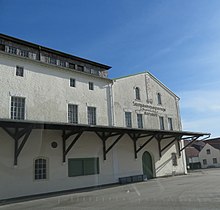Kleinhohenried
|
Kleinhohenried
Karlshuld municipality
Coordinates: 48 ° 40 ′ 22 ″ N , 11 ° 20 ′ 25 ″ E
|
|
|---|---|
| Residents : | 153 (1987) |
| Postal code : | 86668 |
| Area code : | 08454 |
Kleinhohenried is a district of Karlshuld in the district of Neuburg-Schrobenhausen , which belongs to the administrative district of Upper Bavaria in Bavaria .
Landscape and climate
Kleinhohenried is one of the settlements that were created in the late 18th century in the Donaumoos , which was once the largest moor in Bavaria. At that time the moor was to be cultivated and converted into a productive agricultural area.
Kleinhohenried has a temperate but warm climate. The annual average temperature is 8.5 ° C. With an average of 22 mm, February is the driest month, June is the wettest month with 99 mm. On average, there is 757 mm of precipitation per year in Kleinhohenried.
history
In 1799 a settler named Veit Templin settled on Brunner Erdweg, which is now called Paffenhofener Straße. A few years later, the "Colonists of Brandheim" were mentioned in a letter from the Royal Regional Directorate: On August 18, 1807, these colonists were allowed to be relieved of the interest burden. Brandheim was in the area between today's cemetery on Pfaffenhofener Strasse in Karlshuld and the confluence with Kleinhohenried. In 1818 two families lived in a homestead in the desert of Brandheim. The wasteland of Neuhohenried, which later became Kleinhohenried, consisted of two courtyards in which two families lived.
The colonist families in Brandheim and Kleinhohenried were relatively well off financially. In order to free themselves from the high taxes they had to pay for the poor burdens of the entire community of Karlshuld, they applied on December 1, 1848, to be allowed to break away from Karlshuld and form their own community. The Karlshuld community was not interested in this and on January 9, 1849, it pointed out to the royal district court in Neuburg that such a spin-off of Brandheim and Kleinhohenried would threaten the existence of the Karlshuld community. The spin-off application should therefore be rejected. So it happened too. On July 10, 1849, the spin-off application was rejected because it was unfounded.
The fact that the Donaumoos was settled with colonists at all goes back to the initiative of the Imperial Baron and Major General Karl Wilhelm Joseph Adam von Eckart , who bought large amounts of moorland as a shareholder of the Donaumooskultursozietät . From 1790 the Donaumoos was drained and from 1794 a colony was settled. The community name Karlshuld did not yet exist at the time the Hofmark patent was issued in 1795. Because the colonists mostly received too little land to feed on, the economic development of the area was damaged and the moss almost reverted to its original state. But from 1817 the ditches and bridges were rehabilitated and the colonists received land from the state. New colonists were selected, among other things, on the basis of their character traits, because the impoverished families who were the first to settle in the moss had become criminals partly out of necessity. In addition to cutting peat, one could also earn money in a spinning mill that was set up in Karlshuld in 1824. However, this operation closed again in 1830. Basketry, which was practiced intensively until the 1950s, was a long-lived industry in the region. In 1895 the Donaumoos basket industry cooperative set up a basket factory that existed until 1920. It was located on the site of today's seed cleaning plant in Karlshuld. In order to promote agriculture on the difficult soil, the Karlshuld moor research institute was set up in 1898.
There has been a small brewery in Kleinhohenried since 2012. In Lausbiggl Bräu - "Lausbiggl" is the name of the locals for Kleinhohenried - Matthias Köstler brews different types of beer that can be bought in several shops in Karlshuld.
traffic
The nearest rail connections are in Weichering and Niederarnbach .
education
Compulsory schooling was introduced in 1802, but it was not fulfilled in Karlshuld until 1804. Initially, lessons were given in the rectory, in 1829 the first wooden schoolhouse was built, and in 1841 a permanent schoolhouse next to the church of St. Ludwig. In 1856 the girls' school built opposite the church, today's town hall of Karlshuld, was inaugurated. From this point on, the three-story school building was used for the boys' school. From 1834 there were lessons for Protestant children in the Protestant Vikarhaus. In 1964 an elementary school with a gym was built in the municipality of Karlshuld, which was expanded in 1970 and 1992 and is now run as a primary and secondary school. Grades 7 to 9 are also attended by the children from Königsmoos . There is also a kindergarten in Karlshuld.
Culture and sights
The Haus im Moos in Kleinhohenried is an open-air museum with an environmental education and conference center that provides information about the settlement history of the Donausmoos. It opened in 1998.
Individual evidence
- ↑ Pilgrimage on the Donaumoos adventure trail at www.karlskron.de
- ↑ Climate & weather in Kleinhohenried on de.climate-data.org
- ^ Uwe Kühne, Kleinhohenried part of the community at www.karlshuld.de
- ↑ a b Uwe Kühne, The historical development of the Karlshuld community on karlshuld.de
- ↑ Uwe Kühne, A beer for Lausbiggl , August 23, 2014 in Augsburger Allgemeine Zeitung (online at www.augsburger-allgemeine.de )
- ↑ Haus im Moos at www.haus-im-moos.de



